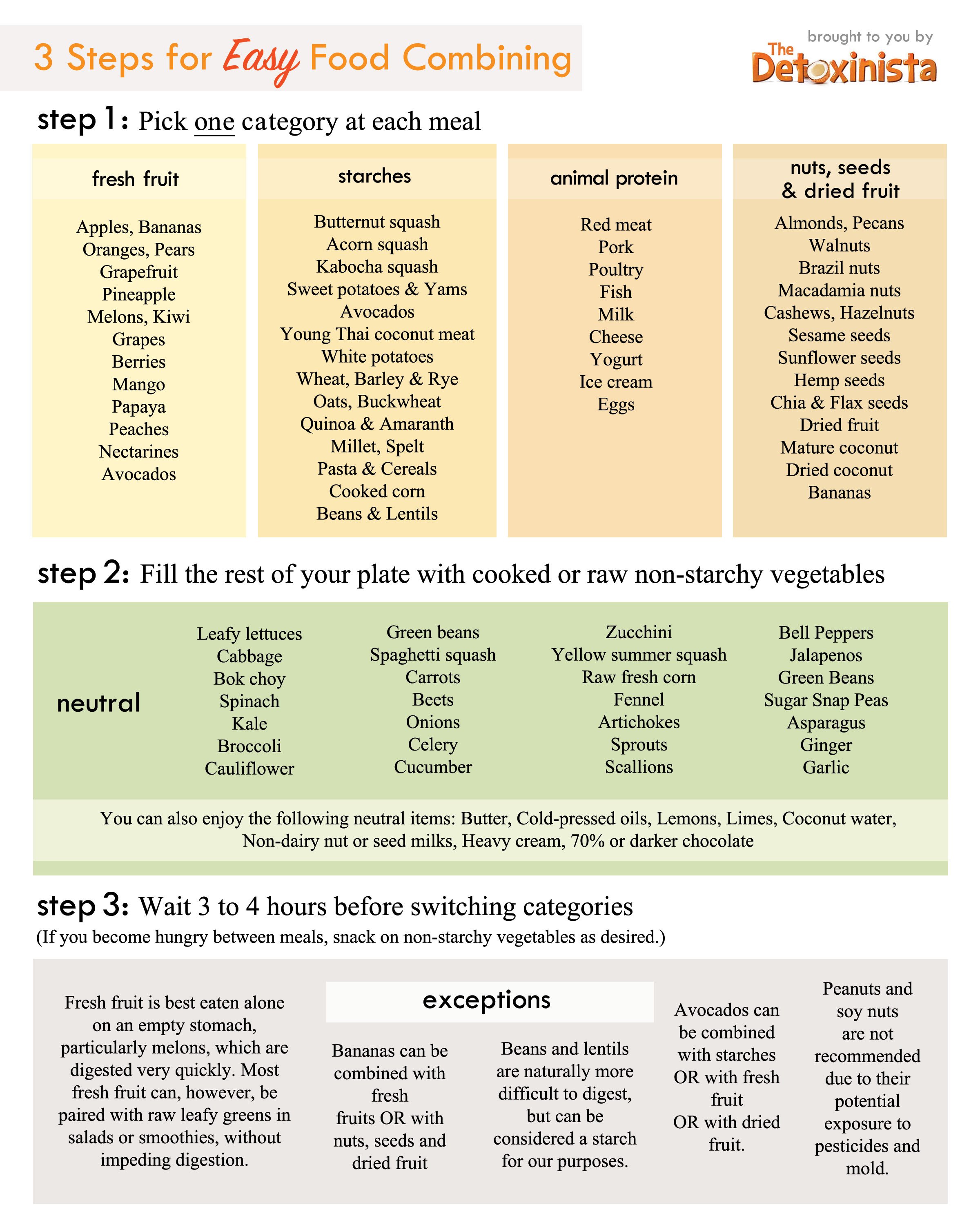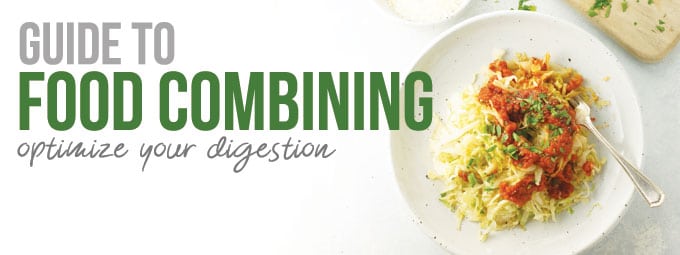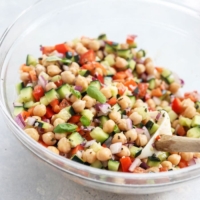Did you know that digesting food requires more energy than any other function in the human body? It’s no wonder we’re exhausted after a big lunch! It stands to reason, then, that the best way to free up some extra energy is to make our digestion as quick and efficient as possible.
Food combining is one of my favorite tricks to streamline the digestive process. Though food combining principles can get very complicated, depending on which expert you ask, I prefer to keep them simple. Simply pick just one dense food at each meal, whatever you’re craving most at that moment, and then fill the rest of your plate with raw and cooked non-starchy vegetables. Easy! By simplifying your meals, the digestive system doesn’t have to tackle too much in one sitting, helping you to avoid that bloated, sluggish feeling that can put a damper on the rest of your day.
Studies have shown that humans have a tendency to overeat when we are offered a wide variety of foods during a meal. (source) So, by simplifying our meals, we will naturally eat less, without counting calories or worrying about portion sizes.
Best of all, you don’t have to give up any food groups that you love– you just may not want to eat them all at the same time. The following guide should help!

As you can see in the chart above, the foods have been divided into four general categories:
- FRESH FRUIT
- STARCH
- ANIMAL PROTEIN
- NUTS/SEEDS/DRIED FRUIT
Note: Look for these food combining labels clearly marked in my cookbooks, and here on the blog. All of the recipes in my cookbooks are properly combined, and both cookbooks include properly combined meal plans to help you easily get started.
For a properly combined meal, simply choose ONE category and only eat foods out of that category for that particular meal. The foods listed within the same category combine well with each other, and you may also include anything from the “Neutral” column to fill out your plate.
Wait 3-4 hours between each meal, before switching categories.
—
Properly Combined Sample Meal Ideas
A properly-combined STARCH meal might look something like this:
A sandwich on whole-grain bread, filled with avocado, mustard, lettuce, tomato and sprouts. Served with a leafy side salad and a baked sweet potato topped with butter. You could follow this meal with some dark chocolate for dessert!
A properly-combined ANIMAL PROTEIN meal might look something like this:
A leafy green salad topped with cherry tomatoes and goat cheese, followed by a piece of baked fish served with a side of roasted broccoli and cauliflower. You could follow this meal with some dark chocolate or goat’s milk ice cream for dessert!
A properly-combined NUT/SEED/DRIED FRUIT meal might look something like this:
A leafy green salad topped with dried cranberries and raw walnuts, followed by a platter of raw hummus served with raw crudités. Dessert could be a slice of raw cheesecake, a few raw macaroons, or a couple raw almond butter cups!
FRESH FRUIT is best eaten in the mornings, on an empty stomach.
This is because fruit digests so quickly, typically within 30 minutes of eating. (However, fruit can be combined with leafy green vegetables in a green smoothie, if you like!) Fruit is not recommended as a dessert after a meal, as it could potentially cause fermentation, gas and bloating, and promote bacterial overgrowth in the body. You can eat fruit as an afternoon snack or post-workout, as long as it’s been 3-4 hours since your last properly-combined meal.
—
Note: There is a lot of debate over the science behind food combining, without much evidence to back it up. (There is little money to be made in this field, which probably accounts for the lack of funded studies.) Personally, I think why food combining works for me, and for many others, is that it encourages you to make better choices, without feeling restricted. When you’re choosing just ONE food category at a time, then filling the rest of your plate with raw and cooked vegetables, you’re bound to be making healthier choices! So, food combining may just work because it encourages the consumption of more whole foods and simpler meals.
I think it’s also important to note that there’s no need to be “perfect” with food combining rules all the time. I like to follow the 80/20 rule, because life’s too short to stress about what you’re eating.
For properly combined meal plans and entertaining menus, be sure to pick up a copy of my first cookbook, Everyday Detox.
My second cookbook, No Excuses Detox, has 3 more meal plans, including a Budget-Friendly properly combined meal plan that feeds you for less than $6 each day, and a Speedy Meal plan that has everything ready in 30 minutes or less. Both of my cookbooks are loaded with properly combined recipes to help make things easier for you.



What about the use of gelatin, collagen and bone broth? Should they be considered neutral or flesh proteins? I’ve always cooked my grains in broth – what are your thoughts?
Since they don’t have fiber, I’d consider them pretty neutral.
That certainly helps simply things. Works for me! Thank you.
I followed the fit for life model for about 8 months. I lost 35 pounds and got down to 6% body fat. However, when I was operated for an appendicitis, I was told I could not eat fruits or vegetables afterwords because it would hurt my digestive tract. I therefore, over the years got older and lazier in my food combinations and consequently gained the weight back. But, once you learn how to food combine, you never forget. It is like riding a bike.
Hi Megan
I love your page and have bookmarked it!
I couldn’t find black coffee on your list. What is optimal to combine with it please?
Great article! Completely agree – just wrote my take on food combining here 🙂 http://www.kaleandtequila.com/revolutionary-world-food-combining/
Can banana combine with dates, some almond butter, spinach and almond milk?
Definitely!
Hmm… you should really add other proteins to the proteins list. I like to eat bean noodles, which have more protein than carbs (not all of them are high-protein/low-carb, but some brands are), and then there are things like tofu, seitan, tempeh, TVP, etc., which wouldn’t really fall under the “starch” category (I once compared 100 calories of each of those to different kinds of cottage cheese, and actually many of them were higher-protein / lower-carb than cottage cheese!).
I haven’t read your blog, so maybe there is some mystical magical reason why you treat animal protein as special (sorry to assume, but a lot of people do based on nothing). I just wanted to point out that many veg sources of protein are actually higher-protein / lower-carb than the options you have under “animal protein”.
When I was first taught about food combining, I was advised to avoid soy completely as it can cause excess mucous in the body and can be an issue for people with a history of thyroid issues. (Thyroid issues run in my family, so I strictly avoid it.) That’s why it was left off of my chart. However, I should modify it for people who can tolerate soy. I would recommend sticking to fermented soy products (like tempeh) and then combining them as simply as possible in a meal– eating them over a leafy green salad, or in a stir fry with non-starchy veggies and cauliflower “rice.”
My digestion is off. Will all of your recipes fall into the food combing rules. I’m not seeing much in food combing but a lot on gluten free. Still trying to figure this out.
Not all of my recipes on the website are properly combined, but all 200 recipes in my two cookbooks are clearly labeled for food combining. They also contain several weeks of properly combined meal plans to help you get the hang of it. Hope that helps!
Thank you.
I have a question regarding food combining. Do you use the categories of fruit, protein, nuts, and starch only for one meal and then the remaining categories for your other meals? Ia m using the food combining to relieve gi issues. I have ordered your books through bn and want to make sure that I am doing this correctly. Thanks Sue
Hi Sue! Yes, you can do it that way if you would like to. Have a fresh fruit meal for breakfast, a starch meal for lunch, and then an animal protein meal for dinner. But, you don’t have to do it that way! I know some people prefer to stick to just one category for the whole day so that they don’t have to worry about the timing of their meals at all– they can eat whatever they want from the same category all day long, and then they switch categories the next day. (This is particularly easy for vegans and vegetarians who don’t consume anything from the animal protein category.) As long as you’re getting plenty of your variety in your diet to keep nourished and emotionally satisfied, you can choose to plan your meals however works best for your lifestyle.
Is it ok to combine a plant based protein and a carbohydrate? For example, beans + bread.
Indeed it is an incredible article that you have shared with us, thank you so much for guiding us through this, this will surely be of great help for healthy life and cooking cannot wait to make this.
I take it I can have a banana with spreaded peanut butter.
Hi. 😊 thanks for the information. I have a question. I’m doing the seed cycle treatment for hormones (2 weeks of flax seeds and pumpkin and 2 weeks of sesame seeds and sunflower) those seeds are considered neutral ? Can I add them to the green juice Add fruit in the morning ? Please let me know. Thanks.
Hi there I am Type 2 Diabetic and I am battling Leaky Gut Syndrome and I having been eating a Vegan diet for awhile now and want to know how to adjust your food pairing plan to accommodate me?? I would be grateful for any feedback.
Joe.
Where does pumpkin fit in? As Australians we eat it as a savoury food often with roasted meats… it’s sooo delicious!
Hi! I have felt a lot better doing fruit on an empty stomach and following that part of food combining.
I do however love a rice cake with sunbutter (sunflower seeds) as my snack – is this technically not ideal because its a brown rice cake combined with a seed? and therefore not ideal?
Just curious!
I eat coconut yoghurt at breakfast with fruit.So I have no idea if this is ok,as not listed. What category does plant based yoghurt fall into and is it ok to eat in this combination.Thanks
Hi
I just wanted to check is combining proteins bad? I’ve read you shouldn’t combine proteins such as red meat and eggs or chicken and cheese is this correct? Do I just choose ONE animal protein and combine with neutral vegetables? OR is it ok to mix animal proteins?
What about kefir (dairy)?
what can I eat with cottage cheese? Can I spread peanut butter or almond butter on a banana?
How should beverages (water, coffee, juice, alcohol) be pulled into the mix?
I rilly believe in eating food together will help you loose. Are the recipes on this websight also the combo recipes like your books? Thanks so much for your info.
No, not all of the recipes here on my website are properly combined, but some are! I’m working on a way to better organize those here, but once you’re familiar with food combining, you’ll be able to recognize it quickly and make modifications easily.
Megan, thank you for a simple approach to healthier eating. Proper food combining has been one of the easiest transitions for me & it has helped me lose weight. Your recipes are easy & delicious!
I was given a recipe from your website by a friend and am so pleased to see your information on food combining! I have ulcerative colitis and a nutritionist years ago taught me about it- and it helps me so much! Cudos to you for sharing! I’m excited to check out and try more of your recipes. Clean eating and food combining are what have helped me more than any doctor or medicine!
Thank You. This is very helpful. 😎
Very interesting and the chart is easy to read. I just purchased your second book and should arrive tomorrow. It’s going to be extremely difficult for me since I basically eat animal protein with starch every meal, lol. But, hopefully after giving this a go, it might help with my digestive issues.
Would you use tomato as a fruit or vegetable? I’d like to combine it with mince meat.
Thanks,
Hazel
Hi, I have had a lot of digestive issues and have been advised about my food combinations. I eating better now and would to purchase the book, but I’m actually trying to gain weight. Is this possible on this kind of diet?
Hi, Megan, I’ve done well with these food combining principles in the past, and am excited to get back on the program. Thank you for your chart – it’s simple and easy to follow! Question: I’m sure wine is not “recommended,” but if I were to have some, what food category does it best combine with?
where does nut butter fall with food combing?
can you have a coffee with milk??
So what do you put on oatmeal if you can’t top with fruit? Can it be dried or cooked fruit?
What combines with mature fresh coconut meat? Would it fall under the same rules as dried coconut??
Hello! Very interesting, I had never read about food combining. Where would tofu be placed? In the “starch” category since it’s made from sybeans? I can’t imagine not ever eating tofu again!!! Thanks in advance.
To the ‘Detoxinita’ of this blog:I’m totally confused by the above sample meal menu’s; some seem to contradict the information given here about food combinations to use. Please explain so I can understand better. If you post it online, I’d also appreciation receiving an email copy so I’m sure to see it. Thank you!
For example, Meal #3–: A nut/seed Meal–aren’t nuts and seeds considered fatty proteins?And hummus includes chickpeas–aren’t these a ‘starchy bean’? I thought protein isn’t supposed to be combined with starches? Please explain.
Another question: I don’t see a separate category in your charts for “Fats”. Are you sayng that any fat can combine with any other food from any other chart category?
One more question: what could protein powder made from seeds combine OK with? or no?(i.e. hemp, chia, pumpkin or flax seeds?)
–or bovine-based collagen petitdes protein powder?
–Or protein powder made from peas: is that still considered a protein, or a vegetable?
Thanks so much, my brain is perhaps missing something and is stressed trying to figure this out.
Hi Barbara! In that example of Meal #3, the zucchini hummus mentioned does NOT include chickpeas. The recipe uses zucchini instead, to keep the hummus properly combined.
Also, food combining is just one tool that you can try. If it’s stressing you out, please don’t do it! It came to me at a time when I was calorie counting and stressing about every little bite, so this felt like “freedom” to me, but if it doesn’t feel that way to you, you might want to look into something like intuitive eating, instead. (Food combining sort of led me to intuitive eating eventually, anyway.)
I don’t think protein powders were something taken into consideration with food combining, because the focus is on simple real foods, but I use hemp hearts as added protein in a banana & spinach smoothie. Since smoothies are sort of pre-digested (since the blender does the chewing for you) I think you could add collagen or protein powder, as you like.
I’m going to get your Everyday Detox and the 5-Day Summer Reset. I have a quick question about smoothies. Is putting protein powder and collagen into your fruit smoothie a no no?
Since smoothies are already “chewed” for you by the blender, I find them much easier to digest– so I think adding something like a scoop of collagen powder should be fine, as long as it agrees with your digestion!
Thank you! This is amazing info. And I learned a lot more about the instant pot cooking here than anywhere else.
Where do oils fit in all of this? Particularly Olive Oil..
And cooked versus uncooked veggies?
Finally soups….Homemade soups
Dried fruit is the same as fruit and digests very quickly. On the other hand, nuts are fat and protein using different digestive enzymes and taking much longer to digest. So, I don’t understand how they can be together in the same category on your chart.
What about white rice?
Hello,
I bought your cookbook fresh and healthy instant pot but the receipts are for 6qt and I have a 3qt. How should I adjust the recipes?
Thank you
I would cut the recipes in half if you think they will fill the pot more than halfway full– especially for soup recipes. The cooking time shouldn’t change too much, but you might need to add an additional minute or two, since the smaller pot should pressurize faster (and de-pressurize faster) than a 6-quart pot.
Thanks for the reply. If it’s a smaller pot and less ingredients wouldn’t I subtract a minute or two instead of adding?
The main reasoning for adding time is that it typically takes a 6-quart pot about 10 minutes to pressurize. (Or more, depending on the amount of liquid.) I think the 3-quart pot might pressurize in only 5 minutes, since it’s smaller, so you’re already reducing the cooking time by 5 minutes just by using the smaller pot. But, it will be something you can experiment with, and you can always return the lid to the pot and cook for another minute if you need to. Or use the saute button and continue cooking with the lid off, until your recipe is done!
Hi!
Which group do oils fits into? I’m under the impression you eat them with fat and vegetables. Can you please clarify? Thanks!
I’ve always been taught that oil is considered neutral since we use such a small amount in most meals. There are far more complicated food combining rules out there, though! I prefer to make it as simplified as possible to prevent any feelings of overwhelm.
Hi Megan, I love your website for food combining it is the best, very easy to read, professional and organized. Thank you so much for your hard work. Do you have any coffee creamer ideas?
Kim
Thanks, Kim! Check out my Vegan Latte or Homemade Coffee Creamer.
Hello there.
Thank you for your charts.
I am a vegetarian (who doesn’t eat nuts or tofu) … who wants to go back to food combining after many years away. I normally eat fruit in the afternoons as my first meal of the day. Then another meal later.
May I ask:
How does drinking cider vinegar affect either a protein or starch meal — meaning — does it interfere with the digestion of either category.
I normally have a couple of hot chocolate drinks in the afternoon made with almond milk and 10g of cocoa powder. Would this class as a starchy drink?
Thank you kindly for your help and advice.
Hi, Can you let me know where Muesli falls in the food combining chart.
Thanks
Andrea
Hi Megan,
I really love leafy greens with acid fruits (pomelo/grapefruit/oranges) or apples/pairs, chia, and nuts.
But can’t find anywhere a defined answer if it’s ok to combine those.
If it’s uncombinable can you suggest something similar that works?
What do you think?
Thanks in advance
What about vinegars?
I sometimes use store bought animal protien substitutes. How do I use them? Are they combined with starches or proteins?
Food combining for those with bodies in an autoimmune state. I coached someone who had diagnosed Graves disease but was on medication and due to fear remained on them during the diet recommended by her GD nutritionist. Now her weight gain is a worry and her energy never returned and headaches stayed. What changed was she nolonger ate and purged what she ate within 20 minutes it went in then back out unchanged. Now it can take days to release. She never changed her diet in 4 years no processed foods. I remember I had done FC diet in the 90s for IBS and it took 18 months to fully heal. Is there a way to structure this for some who already has healthy food but now make it work to counter the imbalance that’s seems to have stayed just went to the opposite way now?
I had forgotten about this program and I was wondering if the quick start guide was still available. I boughr this book and the recipe book but I have lost it. I suffered so long with all the symptoms you mentioned. I highly recommend this program. I have been off this program and all the pain has returned.
Is it ok to combine corn tortilla chips with fresh tomato salsa? If so, how long would it take to digest this meal? Thank you.
I appreciate this so much! Hopefully my bloating and self diagnosed ibs goes away forever lol